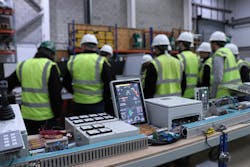New control system extends crane life expectancy
FPSOs are complex assets, acting as a hydrocarbon processing facility condensed to the size of an oil tanker. Overhauling aging or faulty systems on FPSOs can be very complicated and ultimately expensive given the proximity of the crew’s living quarters to the hazardous production areas.
Strict safety regulations are a main priority and must be implemented, and all equipment maintained regularly. As such, effective engineering solutions must be developed to ensure safety while reducing costs and keeping downtime to a minimum.
With sustainability and the drive toward net zero dominating agendas in the energy industry, the lifespan of offshore platforms and vessels is often now extended beyond original expectations. Therefore, component and systems obsolescence are becoming increasingly problematic as original equipment manufacturers (OEM) do not always have the ability to provide ongoing support and maintenance.
Cranes and other mechanical lifting systems are an integral part of day-to-day operations on offshore assets. They are the link between the sea and the platform, from lifting essential cargo like food and water, to large scale equipment which is used in production operations. Without their ability to operate safely, many offshore activities would simply be unable to take place.
Sparrows Group, a global provider of specialist equipment and integrated engineering services, has developed solutions which make it possible to extend the life of these vital offshore assets without the need for complete replacement.
Beyond operating system obsolescence
The company was recently tasked with providing replacement control systems for two Liebherr BOS 40 3600 DEX cranes on an FPSO in North America, a harsh environment featuring sea ice and icebergs. The aim of the project was to extend the life of the FPSO vessel by more than a decade.
To ensure the project was completed successfully, electrical and hydraulic reviews of the existing control system functionality were carried out in close collaboration with the organization’s crane operators. The aim was to retain existing functionality and, where possible, to improve safety through the enhancement of emergency stop functionality, use of plant fail-safe systems and dedicated personnel lift curve.
The project was concluded in one year from the start of the offshore survey campaign to the factory acceptance test of the system, which was carried out in Aberdeen, UK, at the start of this year.
Engineering solutions for extended functionality
A number of challenges were overcome during the project, including reverse engineering the computer-based control system to ensure existing functionality was retained and developing solutions for optimal user experience. Furthermore, the control system safety was improved and optimized.
To understand the functionality of the crane, the computer-based control system was reverse-engineered, the electrical and hydraulic drawings and manuals were reviewed, and interviews were conducted with the crane operators. This work allowed us to gain an understanding of the existing control system and its main functions.
The appraisal team reviewed the functional design specifications and developed an appropriate decision matrix to ensure the new control system would retain the existing functionality, improving safety features where necessary.
Following this, Sparrows’ engineers carried out machine safety risk assessments in accordance with the Machinery Directive harmonized standards EN ISO 12100, EN ISO 13849 Parts 1 and 2, and EN IEC 62061. Subsequently, a gap analysis was undertaken to determine the next steps necessary for the requirements to be met. Based on their findings, the crane’s safety functions were improved to ensure compliance with the most recent guidelines.
The new control system was also redesigned to improve the interface with the crane, providing the crane operator with an increased amount of operational information and a user-friendly interface to access calibrations and limits/alarm setups. New control consoles, drawings, and manuals were provided.
The new control system was based around the Sparrows model that has been used on several crane types. The system was developed in partnership with both Siemens and Xylem AADI and includes a rated capacity indicator, rope speed indicator, operator limit monitoring and automatic overload protection systems.
By upgrading the control systems, the issue of obsolescence of parts can be removed. It makes the whole system more reliable and increases crane uptime. It also removes the need to rely on the OEMs to aid in any troubleshooting for the system in the event of an issue.
The next steps for the project are to ship the systems to North America where one of our specialists will conduct training with the FPSO’s crane operators and technicians. The vessel will then be transported to a dry dock in Spain where the control system upgrade project is scheduled for installation over a two-month period.
Cost-effective lifting solutions
The increase in global E&P activity means FPSOs are continuing to play an important role in the production cycle. They do, however, bring their own challenges as the design intricacy and small workspaces can complicate routine maintenance procedures. As such, the supply chain must develop new, cost-effective processes to ensure that FPSOs can continue to produce hydrocarbons safely and efficiently.
As the offshore wind industry continues to evolve and move into deeper waters, the supply chain must be prepared to adapt to meet new challenges. Effective and reliable lifting equipment is an essential aspect of any offshore installation to ensure it can withstand the harsh environments in which they operate. The company’s design strategies consider all aspects of the equipment and ensure that once deployed, it offers a reliable and effective lifting solution.




